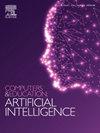探索 ChatGPT 在教育中的矛盾应用:利用 SEM 和 fsQCA 混合方法,通过UTAUT 和 PMT 综合理论分析收益、风险和应对策略
Q1 Social Sciences
Computers and Education Artificial Intelligence
Pub Date : 2024-11-05
DOI:10.1016/j.caeai.2024.100329
引用次数: 0
摘要
ChatGPT 对教育的影响是巨大的,也是不可避免的,它呈现出一种威胁与利益的悖论。虽然已有研究探讨了 ChatGPT 的使用情况、意向和动机,但很少有研究从利益-风险应对的角度来探讨其使用的悖论,这在实践和理论解决方案方面留下了空白。本研究整合了技术接受与使用统一理论(UTAUT)和保护动机理论(PMT),以阐明 ChatGPT 在教育领域的悖论性使用。本研究采用结构方程模型(SEM)和模糊集定性比较分析(fsQCA),旨在为管理教育中与 ChatGPT 相关的利益、风险和应对机制提供见解和解决方案。假设和命题在台湾高等教育用户(N = 351)中进行了测试。SEM 的研究结果证实,对 ChatGPT 严重性的感知威胁会降低使用 ChatGPT 的意愿,而自我效能感和反应效能等应对策略会强烈预测使用 ChatGPT 的意愿。此外,绩效预期和任务效率的益处显著增加了使用 ChatGPT 的意愿,这反过来又显著增加了实际使用行为。fsQCA 的研究结果揭示了 ChatGPT 在教育领域使用和不使用的三种配置。研究确定了三个具有必要条件的构型。本研究将UTAUT和PMT整合到一个统一的框架中,阐明了在使用 ChatGPT 过程中利益-风险-应对的矛盾方面,从而做出了重要的理论贡献。研究还通过 QCA 模型中得到证实的解决方案,为高等教育机构及其学者(如学生、讲师和研究人员)提供了实际意义。这些解决方案为在教育领域使用 ChatGPT 提供了战略启示,以充分利用其益处、识别风险并应对相关威胁。本文章由计算机程序翻译,如有差异,请以英文原文为准。
Exploring the paradoxical use of ChatGPT in education: Analyzing benefits, risks, and coping strategies through integrated UTAUT and PMT theories using a hybrid approach of SEM and fsQCA
ChatGPT's impact on education is both significant and inevitable, presenting a paradox of threats and benefits. While studies have explored ChatGPT's usage, intention, and motivation, few have addressed its paradoxical use from a benefit-risk-coping perspective, leaving gaps in practical and theoretical solutions. This study integrates the Unified Theory of Acceptance and Use of Technology (UTAUT) and Protection Motivation Theory (PMT) to elucidate ChatGPT's paradoxical use in education. Using Structural Equation Modeling (SEM) and fuzzy sets Qualitative Comparative Analysis (fsQCA), it aims to provide insights and solutions for managing the benefits, risks, and coping mechanisms associated with ChatGPT in education. Hypotheses and propositions were tested on Taiwanese higher education users (N = 351). Findings from SEM confirm that the perceived threat of ChatGPT's severity decreases the intention to use it, while coping strategies such as self-efficacy and response efficacy strongly predict the intention to use ChatGPT. Additionally, the benefits of performance expectancy and task efficiency significantly increase the intention to use ChatGPT, which in turn significantly increases actual usage behavior. Findings from fsQCA reveal three configurations for both the usage and disusage of ChatGPT in education. The study identifies three constructs with necessary conditions. This research makes a significant theoretical contribution by integrating UTAUT and PMT into a unified framework to elucidate the paradoxical aspects of benefit-risk-coping in the use of ChatGPT. Practical implications for higher educational institutions and their scholars (e.g., students, lecturers, researchers) are also provided through confirmed solutions from the QCA model. These solutions offer strategic insights to leverage the benefits, identify the risks, and cope with the threats associated with using ChatGPT in education.
求助全文
通过发布文献求助,成功后即可免费获取论文全文。
去求助
来源期刊

Computers and Education Artificial Intelligence
Social Sciences-Education
CiteScore
16.80
自引率
0.00%
发文量
66
审稿时长
50 days
 求助内容:
求助内容: 应助结果提醒方式:
应助结果提醒方式:


